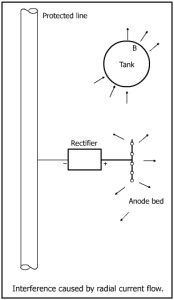Mitigation of DC Stray Current Interference in Cathodic Protection
Any stray current discharging from the buried pipeline to earth will lead to corrosion. The amount of current discharged iss controlled by many factors: coating, potential gradient, current density etc. The basic solution to mitigate such DC interference can be classified the following categories:
1) Minimise the exposure
This means to ensure anode beds is remote to foreign pipelines.

Mitigation with auxiliary earthing
2) Cross bonding
By installation of a current returning path, i.e. crossing bond, the stray current can be returned. Both direct bonding and resistance bonding are utilised in practice. By placing resistance bond, an equipotential can be reached through adjusting the size of resistor by restricting the current flow between two CP systems. It can be achieved by using Ni-Cr wire as resistor.
An example of this mitigation is for stray current between two parallel lines. Current can be picked up by foreign line in some region, and discharged in the other area. In the worst undesirable current flow area, crossing bond should be installed to mitigated such interference.
3) Auxiliary earthing
Magnesium or zinc anodes can be installed as an auxiliary earthing to discharging the stray current. However, the design has to consider the operability of CP system, e.g. CP survey. These discharging anodes should be interrupted as well during survey. One such example is to mitigate radial-flow interference auxiliary earthing mitigation, in which foreign structure is in the current path. The foreign structure will pick up some stray current on one side and discharge it through the other. In this case, the foreign structure is not normally close to the anode bed. By installing the auxiliary earthing, the stray current can be discharged without cause further corrosion of structure.

